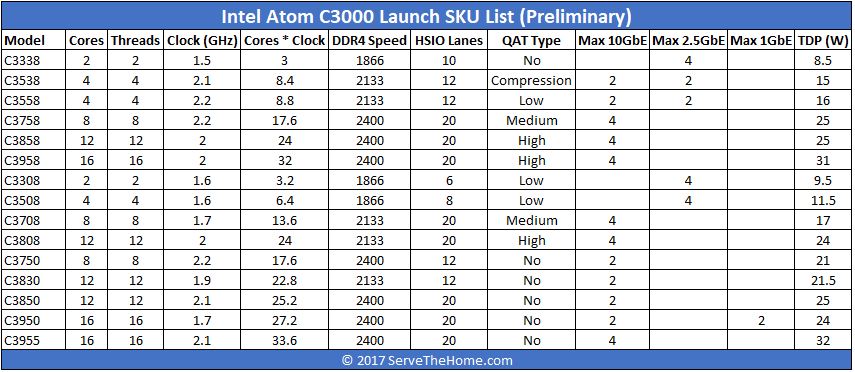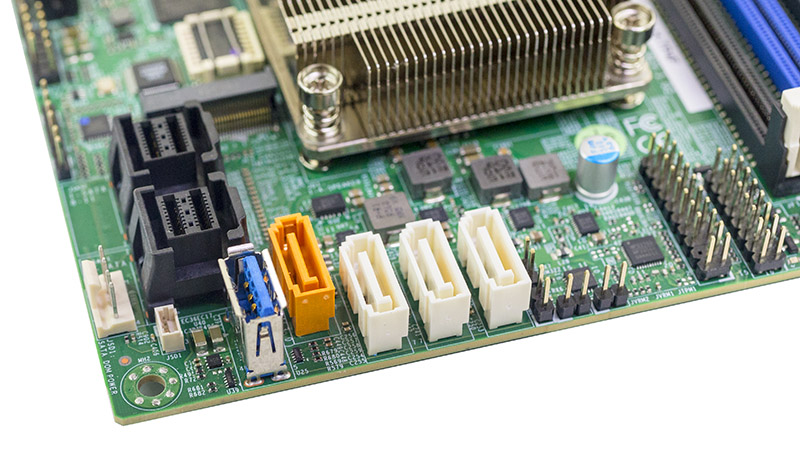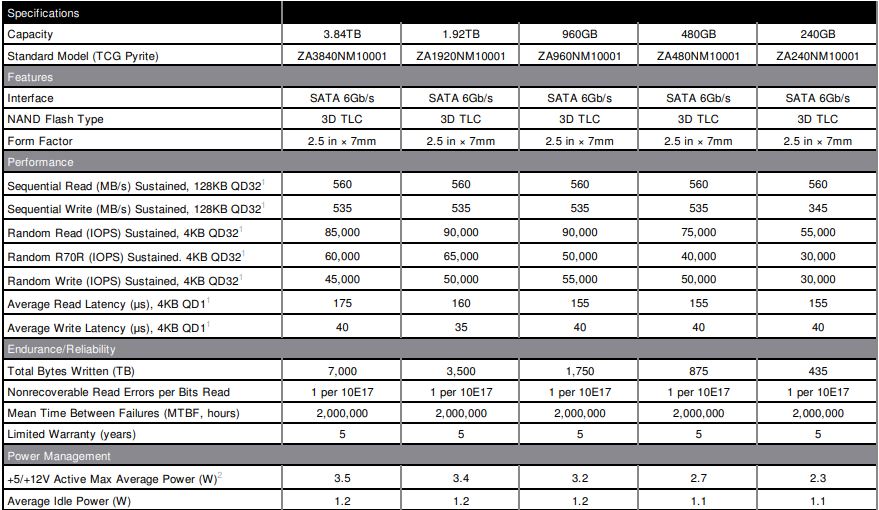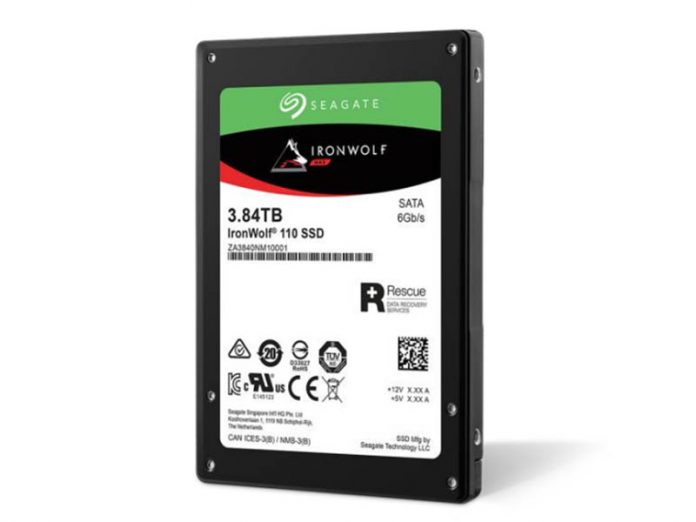At CES 2019, the Seagate IronWolf 110 SATA SSD made its debut. In a time when most in the industry are saying that SATA SSDs are dying, Seagate is boldly betting against that trend with the new line.
Technical Background on “Why” Seagate IronWolf 110 Exists
With most of the enterprise NAND storage migrating quickly to NVMe and SAS3, one may wonder, why SATA. The answer lies in the underlying architecture of the NAS segment. NAS appliances typically use lower power chips such as the Intel Atom C3000 “Denverton” series. The Intel Atom C3000 series is a big upgrade over the previous generation Atom C2000 series. One of the innovations was adding High Speed I/O (HSIO) lanes to the chips.

These HSIO lanes can be used for storage as SATA or PCIe lanes. With lower-end chips like the Atom C3538 which is popular in desktop NAS units like the Synology DS1618+ we reviewed, there are only twelve HSIO lanes. These twelve lanes now usually have 4-8 that are reserved for PCIe expansion. That leaves only a handful of lanes for connecting drives.
Designers can add PCIe SATA controllers that add cost to these platforms, but it is rare to see full-blown SAS HBAs or RAID cards in a desktop NAS. Adding a SAS HBA adds hundreds to the MSRP of a NAS and increases power consumption.

Since designers need to make a choice, most will use the HSIO lanes, or PCH/ southbridge SATA connectivity built into modern platforms for lower-end NAS units. Since many support only 1GbE to 10GbE connectivity, an array of SATA SSDs is able to fill external Ethernet network pipes with data in a NAS scenario.
While the rest of the market is moving to NVMe or SAS, the lower-end NAS segment continues to use SATA because it makes sense. Under this premise, the Seagate IronWolf 110 SATA SSDs are an interesting new product in the segment.
Seagate IronWolf 110 Key Specs
Here are the key specs of the IronWolf 110. You will see the 3D TLC NAND along with the SATA III interfaces. Capacities start at 240GB and double each drive to a capacity of 3.84TB at the high-end.

Frankly, 435TBW on an average prosumer NAS 240GB SSD is a lot, and 7PBW on the 3.84TB drive is more than just about anyone can use. The drives are designed to offer lower power operation and faster speeds than traditional hard drives at the expense of capacity per device. The Seagate IronWolf 110 SSDs also include Durawrite which this video does a good job explaining.
Final Words
At first, launching a SATA SSD in 2019 for an application other than as a boot device seems strange. Then one realizes that NAS manufacturers like QNAP, Synology, Thecus, Drobo, Asustor, and others are being forced to continue offering SATA because of desktop NAS form factors and technical underpinnings. In that context, Seagate is going after what it sees as an emerging NAS market much like Western Digital did with its Red series many years ago. Future generations with 3D QLC NAND will increase capacities and we can see this being a go-to option for NAS units that are in vibration-prone environments like production vans. SSDs have enormous advantages for rugged operation. The Seagate IronWolf 110 is a drive the industry will watch to see how it catches on in the NAS arena.





On the drives, they needed to launch on QLC and higher capacities. You’re still dominated by flash pricing and you’re right they aren’t going to ever see 7pbw.
This is why I come to STH. Not just a PR regurgitation. Great job Patrick and STH team
I understand “HDD for NAS” which I guess should at least provide vibration sensor to save the drive life in NAS environment. But SSD for NAS? What’s so special about it in comparison with usual SSD SATA? How is this IronWolf different from for example Crucial MX500?
>KarelG – according to the specs, Ironwolf’s endurance in TBW is 5 times that of MX500 for similar capacity!
I like them. Home & small biz NAS of file server don’t need much more than this, and spinning disks are feeling too slow.
It’ll come down to price…
So do these drives include the power protection or not.
For my new home storage server I would love to see 8TB or more QLC SSD drives.
It will mainly hold data I don’t access that much or need for speed anyway, so bring it on!
Random thought of course, but good to see a drive like this coming along.
>Bobby Tables: thanks for the correction, indeed, thats the difference. Now, the question is the price of Seagate..
In this product category all the specs are useless until you know what the asking price is.
@Miha: Good question, the data sheet states there is a “Power loss data protection circuit”.
So I assume this means there is full power loss protection, however it would be great if STH could confirm this with Seagate.
If so, it would be a good selling point, assuming the pricing was more affordable than enterprise SSDs.
Nvme is fast, but most consumer motherboards only hold one or two, but then you will easily have 4-8 sata connectors, and you can easily add more with a pcie card. Many consumers are just now starting to go SSD over mechanical. As many things just dump to your main drive (in windows), a 480 gif SSD really only works for laptops, and even a 1tb SSD can feel cramped (man, if I could figure out how to move my OneDrive local copies to another drive, that would take care of a lot of my headaches). 3.4tb SATA SSDs make a lot of sense for the consumer market, if they can keep prices reasonable – I’d jump on one
Amazon has pre orders for these drives:
https://www.amazon.co.uk/Seagate-3-84-IronWolf-Enterprise-Class-servers/dp/B07MDXD7JR/ref=sr_1_4?ie=UTF8&qid=1547219495&sr=8-4&keywords=seagate+ironwolf+110
£893 for the 3.84TB version. Guess I’ll add it to the list of things I’ll never be able to afford!
Sorry Patrick but I completely disagree. Some thoughts in random order:
– 1 HSIO can be configured either as 1 PCIe lane or 1 SATA port, that is about 1GB/s vs. 500MB/s, PCIe is the most efficient and reasonable choice. Full stop.
– 8/10 PCEe lanes are a lot of bandwidth (granted that the cores can keep up) for an entry/mid level NAS, regardless of their distribution (x2 ports would still be a lot of bandwidth for a single NAS NVMe drive). Higher end SKUs have even more HSIO lanes. Maybe the reason OEMs go for SATA or avoid offering both ports is just because they don’t want to kill higher end products.
– No, in such NASes you don’t need any expansion slot once you have PCIe ports (M.2, U.2, whatever) and 10G integrated MAC. Those lanes could well be used for NVMe drives, it’s just a matter of design decision.
– A single NVMe drive can outperform 2/4 SATA drives and 6/10 HDDs, there is less need for parallelization/RAID (indeed, NVMes are not that “I”nexpensive). So, granted you have enough cooling, it doesn’t make any sense to use much denser drives in a big bulky NAS: what’s the point of using 2.5 SSDs in 3.5 slots? Indeed, none. Many NAS should now be conceived differently with respect to the past. It’s much easier to copy and paste old NAS projects with a newer CPU.
– SATA is already a legacy interface, considering that we are now at a point in time where drives are more valuable, reliable and in general outlasting the systems they are attached to, you don’t want to move your SSDs in say 3/5 years to a system that might not have SATA ports anymore.
– Using a HDD wire protocol for NAND memory is nonsense anyway, and shouldn’t be any significantly cheaper nowadays.
– These SATA drives are just a cheap copy and paste design, probably with lower quality/performance NANDs. But unless the price is incredibly cheap it’s really debatable if it’s worth being tied to an old, legacy technology.
Bottom line: SATA does not make sense for low end NAS too, it’s just a matter of money.
> At first, launching a SATA SSD in 2019 for an application other than as a boot device seems strange.
I must definitely be missing something because it’s not obvious to me why this would be strange.